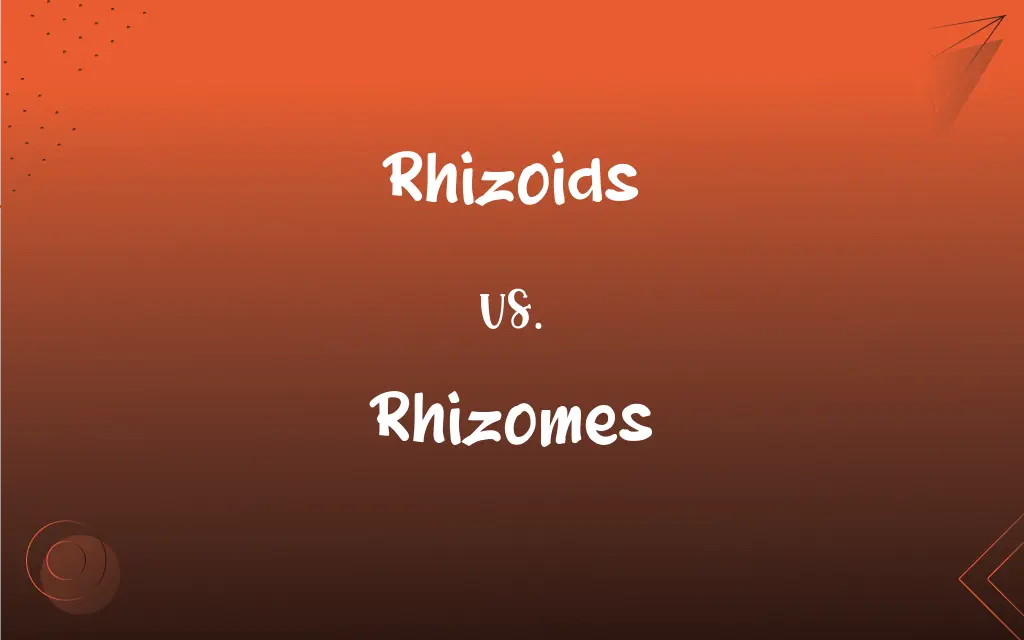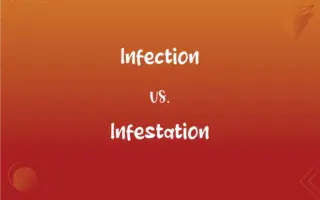Rhizoids vs. Rhizomes: What's the Difference?
Edited by Aimie Carlson || By Harlon Moss || Updated on October 28, 2023
Rhizoids are root-like structures in non-vascular plants for anchorage and absorption; rhizomes are horizontal underground stems in vascular plants for storage and propagation.

Key Differences
Rhizoids, found in fungi and non-vascular plants like mosses, are thread-like structures serving primarily for anchorage and absorption of water and nutrients. Rhizomes, on the other hand, are specialized stems of vascular plants growing horizontally underground, functioning in storage and vegetative reproduction.
Rhizoids lack the complexity and functionality of true roots, as they do not have vascular tissues and are mainly for physical support. In contrast, rhizomes are structurally complex, containing vascular tissues that transport nutrients and water, and they also facilitate new shoot growth for plant propagation.
While rhizoids are single-celled or multicellular filaments without leaves or nodes, rhizomes are multi-celled and bear nodes and internodes, with nodes often giving rise to roots and shoots. This structural difference underscores their varied roles in plant biology.
In terms of propagation, rhizoids don't directly contribute to the reproduction of the plant, but they help establish a secure base for growth. Rhizomes, however, are integral to asexual reproduction, enabling plants to spread and colonize new areas through the growth of new shoots.
Environmentally, rhizoids are adaptations to environments where non-vascular plants thrive, usually moist and shaded habitats. Rhizomes allow vascular plants to survive in various conditions, storing nutrients and energy to endure adverse environmental conditions.
ADVERTISEMENT
Comparison Chart
Function
Anchorage and absorption in non-vascular plants.
Storage, propagation, and nutrient transport in vascular plants.
Structure
Root-like filaments, often single-celled.
Horizontal stems, multi-celled with nodes and internodes.
Plant Type
Found in fungi and non-vascular plants.
Found in vascular plants.
Role in Reproduction
Do not contribute to reproduction directly.
Key in asexual reproduction and plant spreading.
Environmental Adaptation
Adapted to moist, shaded habitats.
Enable survival in various conditions, store nutrients.
ADVERTISEMENT
Rhizoids and Rhizomes Definitions
Rhizoids
Rhizoids absorb water and nutrients from the environment.
The fern's rhizoids soaked up moisture from the surrounding soil.
Rhizomes
Rhizomes serve as storage organs for nutrients.
The iris's rhizomes stored energy for the plant's growth.
Rhizoids
Rhizoids are structures that anchor non-vascular plants to surfaces.
The moss's rhizoids firmly gripped the rock surface.
Rhizomes
Rhizomes help plants survive adverse conditions.
The fern's rhizomes helped it endure through the dry season.
Rhizoids
In appearance, rhizoids resemble roots.
The rhizoids extending from the algae were root-like but simpler in structure.
Rhizomes
Rhizomes have nodes, from which roots and shoots can grow.
The potato plant's rhizomes sprouted new shoots at each node.
Rhizoids
Rhizoids are often filamentous in form.
Delicate, filamentous rhizoids spread out from the base of the liverwort.
Rhizomes
Rhizomes are involved in vegetative reproduction.
New bamboo shoots emerged from the parent plant's rhizomes.
Rhizoids
Rhizoids are found in non-vascular plants, lacking vascular tissues.
The moss's rhizoids, unlike true roots, lacked vascular structures.
Rhizomes
Rhizomes are horizontal stems growing underground.
The ginger plant's edible part is actually its rhizome.
Rhizoids
A slender rootlike filament that grows from an alga, a fungus, or the gametophyte of a moss, liverwort, or fern, used for attachment and nourishment.
Rhizomes
A horizontal, usually underground stem that often sends out roots and shoots from its nodes. Also called rootstock.
Rhizoids
Plural of rhizoid
Rhizomes
Plural of rhizome
FAQs
What are rhizoids?
Rhizoids are root-like structures in non-vascular plants for anchorage and absorption.
Can rhizomes store energy?
Yes, rhizomes store nutrients and energy for the plant.
Are rhizoids found in all plants?
No, rhizoids are primarily found in non-vascular plants like mosses and liverworts.
What are rhizomes?
Rhizomes are horizontal underground stems in vascular plants for storage and propagation.
How do rhizoids contribute to plant stability?
Rhizoids anchor non-vascular plants to their substrate, providing stability.
Can rhizomes help in plant propagation?
Yes, rhizomes are key in vegetative reproduction and help plants spread.
Can rhizomes be used for human consumption?
Yes, some rhizomes like ginger and turmeric are edible.
What environments do rhizoids thrive in?
Rhizoids commonly thrive in moist and shaded environments.
Do rhizomes play a role in plant survival during droughts?
Yes, rhizomes can store water and nutrients, aiding plant survival during droughts.
Do rhizomes have leaves?
Rhizomes themselves don't have leaves, but shoots growing from their nodes can have leaves.
What's the difference in complexity between rhizoids and rhizomes?
Rhizoids are simpler, lacking vascular tissues, while rhizomes are complex with nodes and internodes.
Are rhizoids visible to the naked eye?
Rhizoids are often visible as tiny, hair-like structures.
Do rhizoids absorb minerals from the soil?
Yes, rhizoids can absorb minerals and water from their surroundings.
Can plants have both rhizomes and roots?
Yes, many plants have both rhizomes for propagation and roots for nutrient uptake.
How do rhizoids differ from roots in structure?
Rhizoids are simpler, lacking the complex structure and vascular tissues found in true roots.
Do rhizoids transport water and nutrients?
Rhizoids absorb and transport water and nutrients, but lack the efficiency of true roots.
How do rhizomes survive in adverse conditions?
Rhizomes store energy and nutrients, allowing plants to endure harsh conditions.
Are all underground stems considered rhizomes?
Not all; rhizomes are a specific type of underground stem adapted for storage and propagation.
How do rhizomes grow directionally?
Rhizomes typically grow horizontally underground.
About Author
Written by
Harlon MossHarlon is a seasoned quality moderator and accomplished content writer for Difference Wiki. An alumnus of the prestigious University of California, he earned his degree in Computer Science. Leveraging his academic background, Harlon brings a meticulous and informed perspective to his work, ensuring content accuracy and excellence.
Edited by
Aimie CarlsonAimie Carlson, holding a master's degree in English literature, is a fervent English language enthusiast. She lends her writing talents to Difference Wiki, a prominent website that specializes in comparisons, offering readers insightful analyses that both captivate and inform.































































